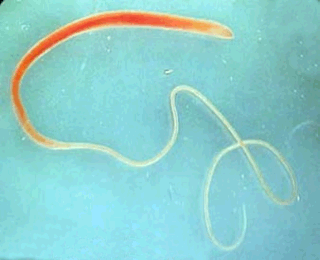Classification:
Phylum: Nematoda
Classification: Adenophorea
Scientific Name: Trichuris trichiura
Common Name: Whipworm
Classification: Adenophorea
Scientific Name: Trichuris trichiura
Common Name: Whipworm
General Characteristics:
Whipworms have an elongated anterior end that contains the mouth and esophagus that stretches to a point. The posterior end of the worm is more blunt and contains the anus and sex organs. Males are typically 30-45mm long while females are typically 35-50mm long. Females produce large amounts of eggs per day and males have a single spicule that protrudes through a round sheath with spines for copulation. Females produce nearly 5000 eggs per day into the lumen of the hosts gut. When the eggs are excreted through feces, the eggs take 21 days to mature under the proper conditions. If the eggs are consumed, they move down the digestive system of the host and into the small intestine. When the eggs hatch, they burrow into the epithelial lining and mature. It takes approximately 4 molts for the whipworm to reach maturity.
Habitat:
The whipworm inhabits humans and monkeys as an endoparasite. In order for the whipworm to be transmitted effectively, there must be poor sanitation along with a warm, moist climate. They are found around the world in temperate and tropical climates.
Importance to Humans:
Whipworms are fairly common parasites to humans. An estimated 1 in 5 people are carriers of whipworm world-wide. There is a one percent infection rate in the United States. The drugs Albendazol and Pyrantel are both effective treatments of whipworm infections.
Sources:
Fraumann, Robert. "Trichuris trichiura". Animal Diversity Web. Retrieved from: http://animaldiversity.ummz.umich.edu/accounts/Trichuris_trichiura/.

